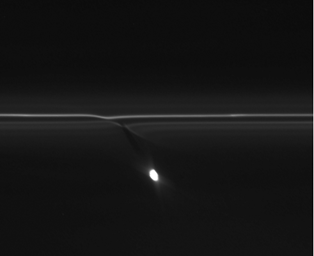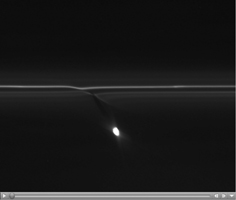
|
F Ring Patterns
- Click the image above for a larger view
 Movie Download Options
Movie Download Options- Full-Res JPEG (491 x 400) (5.4 kB)
- Full-Res TIFF (491 x 400) (196.8 kB)
Caption:

Click on the image for the video
In this movie from NASA's Cassini spacecraft, the gravitational pull of Saturn's moon Prometheus creates patterns in Saturn's F ring. This movie also happens to show a small trail of icy ring particles dragged out when a tiny object punches through the ring. That trail appears at the top right about 12 seconds into the movie and moves along the length of the F ring to the left.
This movie covers 11 hours and 5 minutes on Jan. 30, 2009. The images were re-projected so that the frame is centered on the moon Prometheus, highlighting the interaction between the F ring and Prometheus.
Prometheus, which averages 53 miles or 86 kilometers across, is the bright body moving up and down in the frame. The delicate strands of the F ring run across the top of the frame. The trail, made of icy particles dragged out of Saturn's F ring, varies from about 47 miles (75 kilometers) long to 155 miles (250 kilometers) long over the course of the movie.
Scientists think the trails, also called "mini-jets" by Cassini scientists, are created when small objects about half a mile (1 kilometer) in diameter punch through the F ring and drag icy ring particles behind them. The objects creating the trails were likely originally formed by the pull of the moon Prometheus on tiny F ring particles.
As the moon works its way around Saturn, its gravitational attraction sometimes parts channels in the icy particles of Saturn's F ring and sometimes pushes together sticky snowballs. The moon's continued progress around Saturn pulls some of the snowballs apart over time and adds material to others. These trails appear to be the telltale signs of surviving, evolved snowballs that strike through the F ring on their own. Scientists have been able to use Cassini images to track the objects and be sure they have different orbits from the F ring. The collisions occur at gentle speeds, on the order of 4 mph (2 meters per second). The F ring is the outermost of Saturn's main rings, with a radius of about 87,129 miles (140,220 kilometers).
A shorter version of this video with the original projection can be seen at PIA15500 . A similar movie showing Prometheus' interactions with the F ring in 2006 can be seen at PIA08397 .
The images were obtained by Cassini's narrow-angle imaging camera. Other examples of these trails can be seen in PIA15500 , PIA15502 , PIA15503 and PIA15504 .
Background Info:
The Cassini-Huygens mission is a cooperative project of NASA, the European Space Agency and the Italian Space Agency. NASA's Jet Propulsion Laboratory, a division of the California Institute of Technology in Pasadena, manages the mission for NASA's Science Mission Directorate, Washington, D.C. The Cassini orbiter was designed, developed and assembled at JPL. The imaging operations center is based at the Space Science Institute in Boulder, Colo.
For more information about the Cassini-Huygens mission visit http://saturn.jpl.nasa.gov and http://www.nasa.gov/cassini . The Cassini imaging team homepage is at http://ciclops.org .
Cataloging Keywords:
| Name | Value | Additional Values |
|---|---|---|
| Target | Saturn | F Ring, Prometheus, Saturn Rings |
| System | Saturn | |
| Target Type | Planet | Ring, Satellite |
| Mission | Cassini-Huygens | |
| Instrument Host | Cassini Orbiter | |
| Host Type | Orbiter | |
| Instrument | Imaging Science Subsystem (ISS) | |
| Detector | Narrow Angle Camera | |
| Extra Keywords | Collision, Grayscale, Movie, Visual | |
| Acquisition Date | ||
| Release Date | 2012-04-23 | |
| Date in Caption | 2009-01-30 | |
| Image Credit | NASA/JPL-Caltech/SSI/QMUL | |
| Source | photojournal.jpl.nasa.gov/catalog/PIA15501 | |
| Identifier | PIA15501 | |
